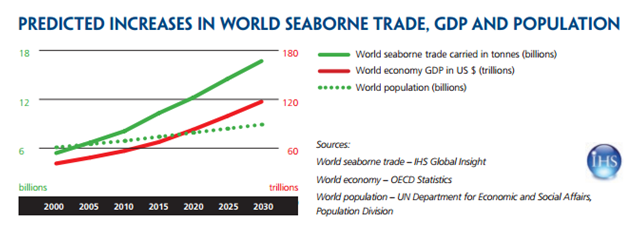Shipping and world trade: driving prosperity
Shipping’s ability to offer economic and efficient long distance transport puts it at the centre of the world economy.

Some 11 billion tons of goods are transported by ship each year. This represents an impressive 1.5 tons per person based on the current global population. Shipping’s capacity to transfer goods and materials from where they are produced to where they will be ultimately consumed underpins modern life.
For an economic region such as the European Union, shipping accounts for 80% of total exports and imports by volume, and some 50% by value.
As of 2019, the total value of the annual world shipping trade had reached more than 14 trillion US Dollars.
Helping to house, move and feed populations
Each year, the shipping industry transports nearly 2 billion tons of crude oil, 1 billion tons of iron ore (the raw material needed to create steel), and 350 million tons of grain. These shipments would not be possible by road, rail or air.
Such raw materials allow countries to create industries, construct cities, house and move populations, and transform resources into refined products for re-export. This ability to add value drives prosperity, and enables developing countries to scale up.
Large volumes of other key products such as chemicals, refined fuels and manufactured goods are also shipped by sea.
To support world economies, shipping has developed highly sophisticated logistics chains delivering just-in-time parts and goods to manufacturers and consumers. Avocados, for example, are shipped from Chile to arrive in Europe just as they ripen.
0.3p to ship a cup of coffee
Shipping also offers the cheapest mode of transport per ton: sea transport contributes just 0.3p to the £2.50 cost of a cup of coffee, 20p to the £5 cost of a bottle of wine, and $5 to the $100 cost of a Nike trainer.
This underlines shipping’s ability to transport goods cheaply and in large volumes, and with a minimal environmental footprint.
Over the last four decades, seaborne trade has quadrupled in size, bringing benefits for consumers worldwide through competitive freight rates.
Shipping
- Allows countries to access the raw materials needed to develop their economies.
- Enables the manufacture and export of affordable goods and products.
- Has the lowest environmental footprint in the transport segment on a per-ton basis.



